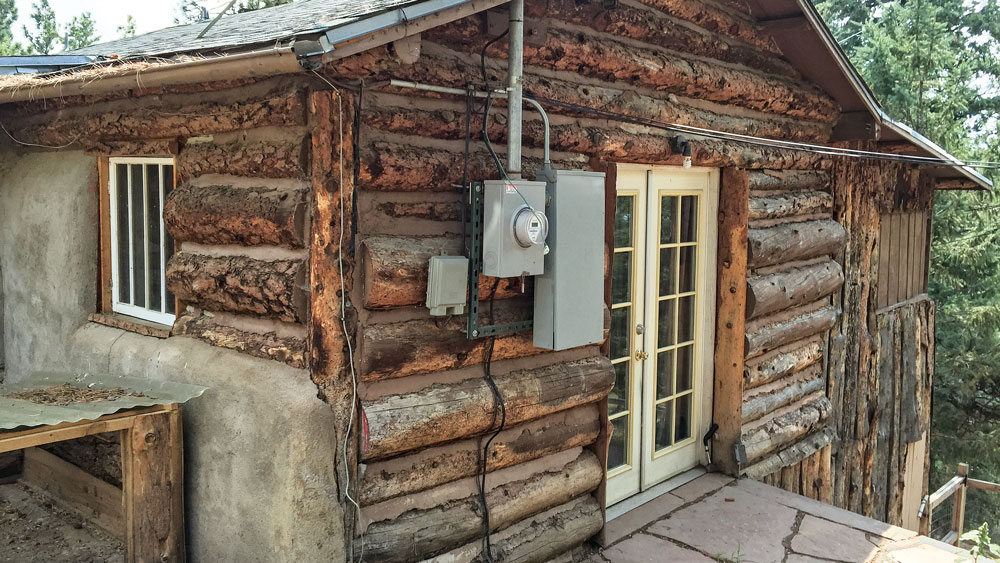Photos by Alex Charvat
Mid-century modern— it’s a term so frequently used on home repair shows that it’s on tap to be a TV drinking game. What about “pre-century historic”? Ever hear that?
Probably not, but it’s safe to say that log homes have been around a long time before that “historic” mid-century modern was built. And more interestingly, they continue to be built. Log homes are literally a timeless form of shelter in this country, and some of them have been around 200 years or longer.
The idea of restoring any type of antique can excite the imagination, but in home restoration, it can also mean anxiety about unknown repair costs. The 1970s, 80s and 90s were something of a boom in the log home industry, where manufacturers capitalized on Horace Greeley’s famous “go west young man” advice and offered log home kits that simplified the dream of owning a cabin getaway. As the decades passed, log home design got increasing bigger and more complicated, often to the point of exceeding its cabin intentions and landing squarely in trophy-home status.
Ah, but in this era of fix-and-flip, many of those late 20th century kit-cabins offer a good real estate deal and a taste of a simpler log home life. The trick is to uncover potential issues: What can be fixed and what should to be scrapped?

Find the Right Home to Renovate
I tell my clients that engineering a new cabin of any design, or repairing an old one in any condition, is always possible – the design or repair is not the issue, but rather, can it be done within their budget? Just as important as cost is the return on investment (ROI). This means that if $1.00 is spent on repairs, those repairs need to produce a financial benefit greater than the cost. If the return is $1.05 then no money was lost. If the return is $1.50 you did well, and if it’s $2.00, you need to be writing this article.
So how is this done in the log home realm? Look for homes that have only cosmetic or minimal structural issues. Lots of existing log home repair costs are associated with updating flooring, windows, paint/stain colors, bathrooms, cabinets, etc., and are no different than renovating a stick-framed home. Log home-specific concerns are what will be discussed here.
See also Remodeling a Log Home
1. Check the structure
First and foremost is structural soundness, and that starts with the foundation. The foundation does two things: it provides a stable support for the typically heavy log walls and keeps the logs dry by avoiding contact with the ground. Centuries ago, that foundation was often a dry-stacked rock wall; though temporary cabins, like trapper shacks or mining quarters, often stacked the logs directly on the ground. Obviously, a poured concrete foundation is ideal, but rock foundations have kept log walls dry and structurally sound for centuries. (Logs stacked on the ground should be a deal breaker.)
By today’s building codes, logs need to be at least 8 inches from the finished grade; 2 feet is ideal. A few hairline cracks in a foundation wall are expected over time. Cracks spreading more than one-quarter inch wide and extending several feet or more should be inspected by a structural engineer.
In an older home, the logs likely weren’t structurally graded, and chances are the home plans were not reviewed by a structural engineer. But look at it this way: Abe Lincoln wasn’t a structural engineer, nor were the logs used in his little cabin graded, and it’s still standing, so it’s not all bad news. The simpler the home, the higher the probability that it was done right. If anything is visibly out of whack, like sagging beams, sloping floors, sticking windows and doors, leaning posts, etc., it may be best to move on.
However, if the house is still a top contender, get a structural engineer involved. Every log home is constructed slightly different, and that means every structural repair solution is different, too.
Keep in mind, however, that some “flaws” you may see really aren’t a problem at all. I get several calls a year regarding the logs in a house “splitting.” Technically speaking, this splitting is called “checking,” and checks are not a structural defect. Checking is natural to the log-drying process. As a log dries, it seeks equilibrium with its environment and, as a result, it shrinks in a non-uniform way. This creates internal stresses in the log, and in doing so, the log fibers open up to relieve the stress. As long as the check is not through the log (as in you can see daylight on the other side), it’s generally not a structural issue, and checks create unique character in a log home.
2. Look for signs of moisture
Wood is a biological material, perfectly engineered to withstand the harshest of weather while it’s alive. When dead, however, it’s the lifeblood of decay-seeking organisms. With few exceptions, decay needs moisture to thrive. Eliminate moisture, and you eliminate decay. Eliminate decay, and you prevent the structural deterioration of a log house.
A few of the key moisture-related warning signs are discoloration between the logs (do the logs lower to the ground seem darker than the others?); softness (can you easily poke a pencil or a fingernail in the surface?); evidence of fungus (this can be brown, black or white/gray); and obvious decay (rot).
There are different types of rot (e.g., brown or “dry” rot, white rot and soft rot) and each has varying degrees of severity. In some cases, the log can be saved; in others, it has to be replaced, which can get expensive.
The key with moisture is to look for the source of the water, determine how easy it will be to fix/remove the source and then assess how feasible it will be to repair any damage that may have been done by that source to the log.
3. Be aware of log species and style
The truth of the matter is that no wood species is a “bad” choice, especially if the existing log home you’re considering was well maintained. But some species do stave off decay a little better than others. Western red cedar, Port Orford cedar, Alaskan yellow cedar, redwood, cypress and white oak, are a few examples of decay-resistant species. The more resistant species tend to grow in wetter regions and need to be naturally moisture-resistant to thrive. Ironically, decay-resistant species tend to be softer and not as strong; so it’s a trade off.
As for log style, it’s mostly a personal preference. The concern here is whether proper maintenance for that particular log style has been done. Lots of log home kits were manufactured with milled logs due to the economy of scale that could be created using a factory controlled product. Thinner logs have lower R-values and a lighter structural-load capacity, but neither of these factors may matter on a small home in a warmer climate.
Larger log diameters have higher R-values, increased thermal mass, more structural capacity and take longer to deteriorate — simply because they are bigger. So if any decay is present on a bigger log; it might be shallow enough that it hasn’t affected its structural integrity.
Look for sealant between the log courses, chinking that’s in good condition, stain that still repels water, tightly fit corners and log joints, and, most importantly, no visible daylight between the log courses. If the stain is just a few years old, it’s not a big deal. Three decades old? That’s a completely different situation. It’s not that these issues can’t be fixed; it’s the expense required to do so, and that expense is magnified by the length of time a problem has been around.
See also The Top Remodeling Project of the Year: Garage Doors
4. Age Might Not Be a Problem
Age is a bittersweet topic. As human beings, we tend to think that old is bad, and, well, for us it generally is. However, if we think of wine or scotch, age has an entirely different (and desirable) meaning.
In terms of log structures, Europe is full of wood homes, churches and barns that are hundreds of years old. The concern with age is how well the logs were taken care of. Neglected logs can be an issue in a matter of years; maintained logs can last for centuries. So the logs need to have been properly and regularly cared for.
As for the “do they get better with age” question, like wine and scotch, the answer depends on many factors. Architecturally, age represents an era of design thinking, and that design may or may not be personally appealing.
Seeing an old historic cabin, with tool marks still visible from an era long gone, is beautiful to many. Only time can give wood that distinctive aged patina and texture. Low ceilings and small walled in spaces of the early 1970s, however, not so appealing. Open great rooms with vaulted ceilings and cozy lofts are what today’s log home buyer typically wants.
The issue here is entirely personal preference. Neither is better than the other, but architectural style is not something that is easily or inexpensively changed. If the floor plan is not love at first sight, you may want to think twice.

Assess the Repairs
When you’re considering an older log home, be sure to carefully assess what kind of repairs will be needed. Some will be mere cosmetic changes, ranging from painting the kitchen cabinetry to replacing the tile flooring in the master bath. Others will be architectural —still reasonably doable in the grand scheme of things, but a little more complex than a simple facelift. And then there are structural issues, some of which are able to be repaired, but other, more serious problems should make you walk away. It’s important to recognize the difference.
1. Structural repairs
“Structural” means anything to do with physically supporting the house, such as the foundation, log walls, posts, beams, trusses, joists and so on. At their best, structural issues can cost a small fortune to remedy; at their worst, they can pose a safety threat to you and your family. Sometimes structural surprises can pop up even after a thorough inspection. If they do, don’t panic, but hire a structural engineer who understands log homes. Structural analysis of a log home isn’t difficult; it’s just different than stick-framed houses, and though a general contractor may be highly competent, when it comes to log structures, he/she may not know what to look for. Getting it wrong can translate to significant and potentially compounded problems in the future.
2. Architectural repairs
This is the “what it looks like” stuff, such as cleaning the logs, applying new stain, sanding wood floors, resealing tile, replacing carpet, updating countertops and so forth.
Occasionally a non-load-bearing wall may be taken out to open up and modernize the space — a great idea when it’s an option. Fixer uppers are all about the architectural makeovers. It sounds super easy to pick out countertops and cabinetry, but get it wrong and $10k or more can be shaved from your asking price (if it’s an investment property) or you may be dissatisfied with the outcome (if this is your forever home). Just like enlisting a pro to fix the structural issues, consulting with an interior designer for ideas is money well spent. It’s not as easy as it looks.
See also Bathroom Makeovers for Less Than $100
3. Materials Needed for Restoration
When restoring a log home, the decision to use modern or period-original materials can be tough. Using modern materials may be mandated by code. For example, as traditional as they are, wood roof shingles, like cedar shakes, are banned in many forest-fire-prone areas. Obviously wiring and plumbing and other safety concerns must be updated with modern materials, per building codes, but other items, such as flooring and cabinets can stay true to the period of the house. Reclaimed materials add a unique and historic look, which is popular right now, but simple improvements, like making cabinet pulls out of old hand tools or taking wood from a collapsing barn and repurposing it as wainscoting for an accent wall, can make a simple, powerful and affordable statement.
As for the repairs themselves, they are not technically difficult or sophisticated. Log home repairs are about labor … generally lots of painstaking labor. For the advanced do-it-yourselfer, YouTube is a good place to look for how-to videos, from both professionals and industrious amateurs, on log home repairs. If you want to tackle it yourself, but would like a little hands-on guidance, try hiring a professional to work along side you for a day or two. If you don’t feel confident about your abilities, or you simply want to play it safe with one of the biggest investments you’ll make in your life, hiring a professional for all the work is a great way to make sure it’s done right. This is not the time to be penny wise and dollar foolish.

Buy Wisely
Finding a log home fixer upper is fairly easy. However, making a smart choice can be a challenge. Homes tend to be the largest purchase people make, and when all is said and done, its value after the repairs and improvements should exceed the cost of the home plus the cost of the repairs. Buying the wrong home or ineffectively using money on repairs can ruin this equation quickly.
The best advice is to work with experts who’ve been there. Yes, you can expect to pay for that experience, but you also can expect a superior outcome. Using the cheapest bid is generally not the answer. This is not to imply that you can’t tackle some (or all) of the work yourself. Just be sure that any work done, is done right.
In the log home restoration industry, there’s a saying: If you don’t have the time or money to do it right the first time, you’re definitely not going to have the time and money to do it right a second time. Make a wise and informed decision. Look for a structurally sound home that hasn’t had any potential long term water exposure on the logs. Aim for homes that show signs of regular maintenance and consider it a bonus if the log species is naturally decay resistant. The age of the home isn’t an issue, provided the maintenance has been kept up. Choose a style and floor plan that are appealing to you with minimal changes. Use an expert to prioritize repairs and keep the reno consistent with that of a log home. And finally, never try to make your log home something it’s not.
See also Creating a Budget-Friendly Construction Schedule
Alex Charvat is a licensed engineer with a background in forestry structural engineering. He’s worked as a forester in the Pacific Northwest, has engineered and designed hundreds of log homes and is the engineer of record for NAHB’s Log & Timber Homes Councils’ log grading program. He’s hosted his own log cabin renovation show for the DIY Network called “Cabin Rescue,” with another program in development. Alex owns Alexander Structures, Inc., a national engineering and design firm. He can be reached at alex@alexanderstructures.com.
























